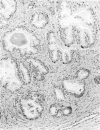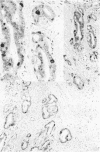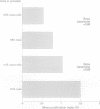Abstract
AIM: To assess cell proliferation in early prostate cancer and associated pathological lesions. METHODS: Using the Ki-67 antibody, the cell proliferation index was measured in early stage prostatic carcinoma in 37 incidental tumours diagnosed at transurethral prostatectomy (TURP) and in 20 low volume cancers treated by radical prostatectomy. Proliferation indexes have also been measured in areas of normal peripheral zone, transition zone hyperplasia, atrophic appearing lobules, and high grade prostatic intraepithelial neoplasia in the radical prostatectomy cases. RESULTS: In the TURP series the proliferation index correlated with grade and stage. Logistic regression analysis, however, showed that Gleason grade was the most reliable predictor of biopsy proven residual disease and clinical progression. In the radical series transition zone carcinoma the proliferation index was half that of peripheral zone carcinoma. The atrophic lobules also showed a high proliferation index of the same order as seen in the peripheral zone carcinoma. Normal peripheral zone showed the lowest proliferation index and in hyperplastic transition zone it was also less than the other areas. CONCLUSIONS: There is only limited support for the correlation of proliferation index with grade in early stage prostatic carcinoma. The findings do not suggest that proliferation index adds to the prognostic information given by grade and stage in pT1 disease. The significant difference in proliferation index in transition zone and peripheral zone carcinomas supports the morphological distinction of these tumour types and is consistent with differences in biological behaviour. The high proliferation index in lobules considered morphologically atrophic is reminiscent of previous observations in which carcinoma was spatially associated with atrophy.
Full text
PDF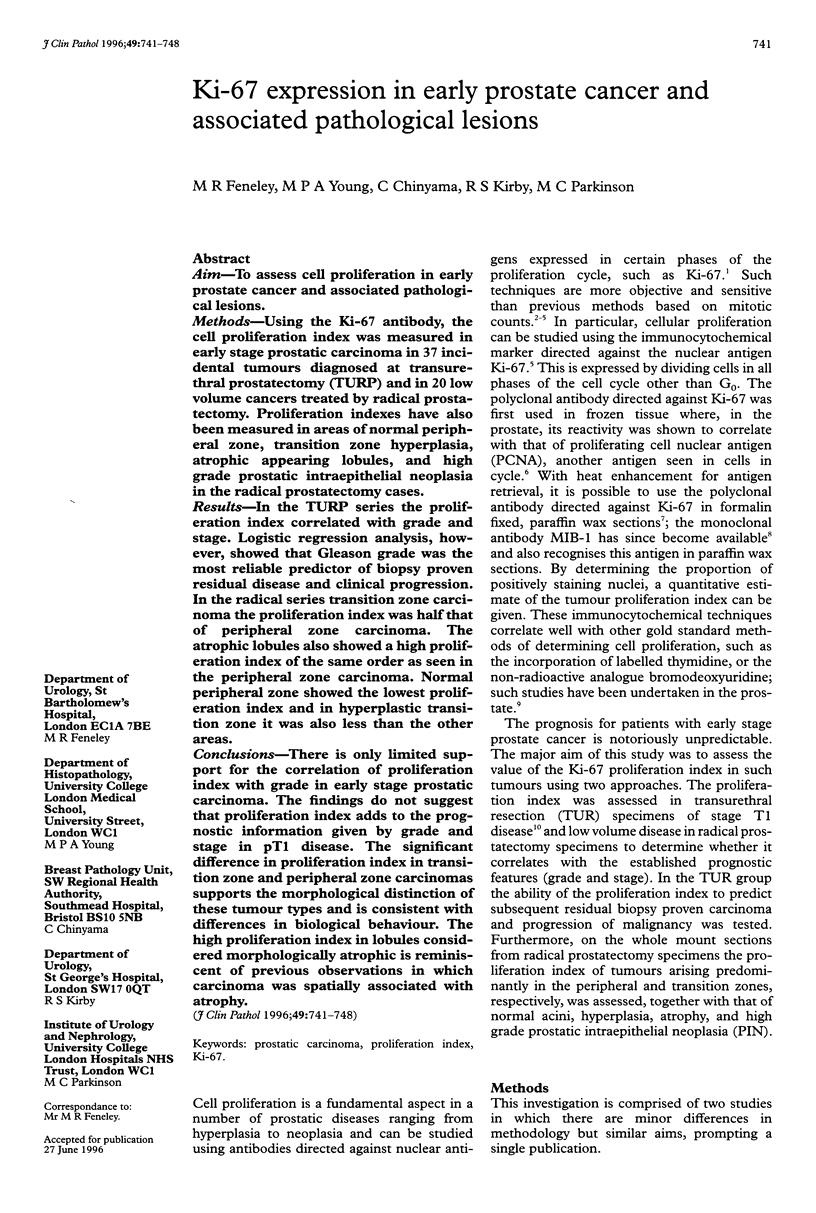
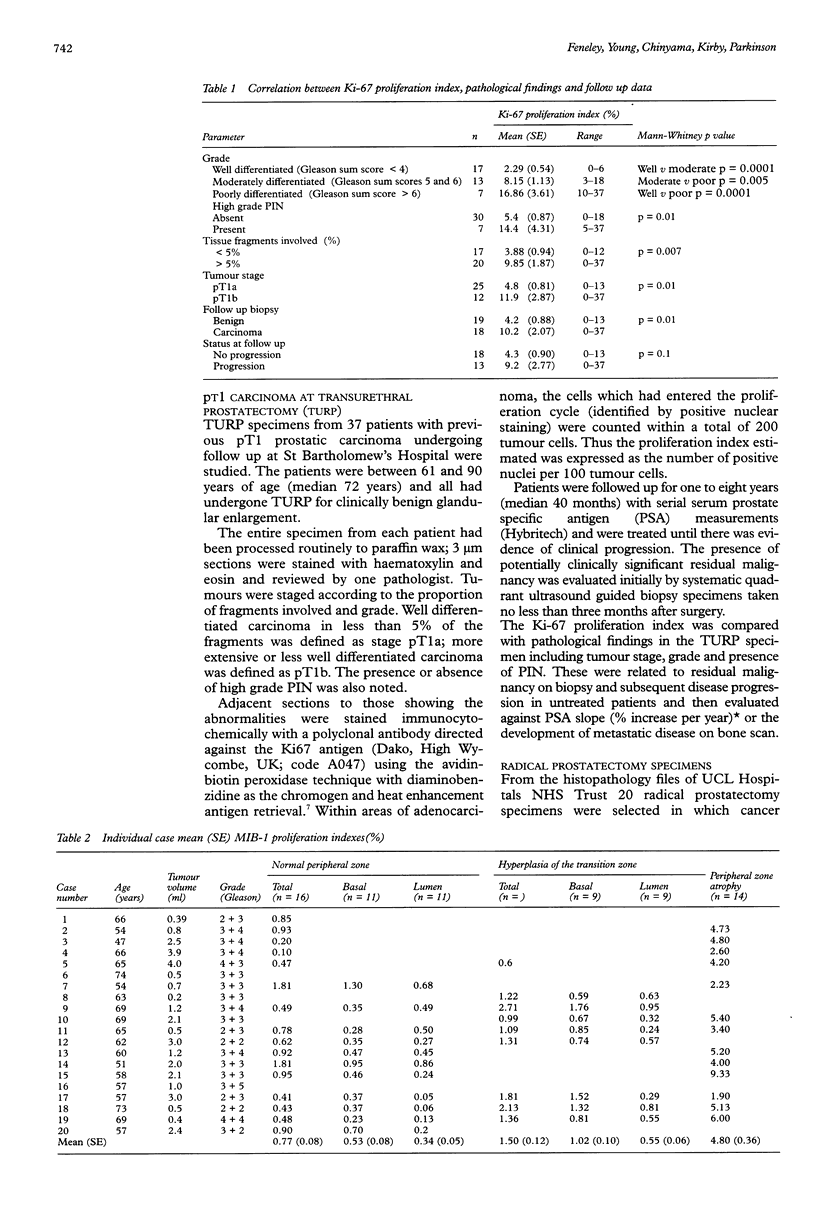
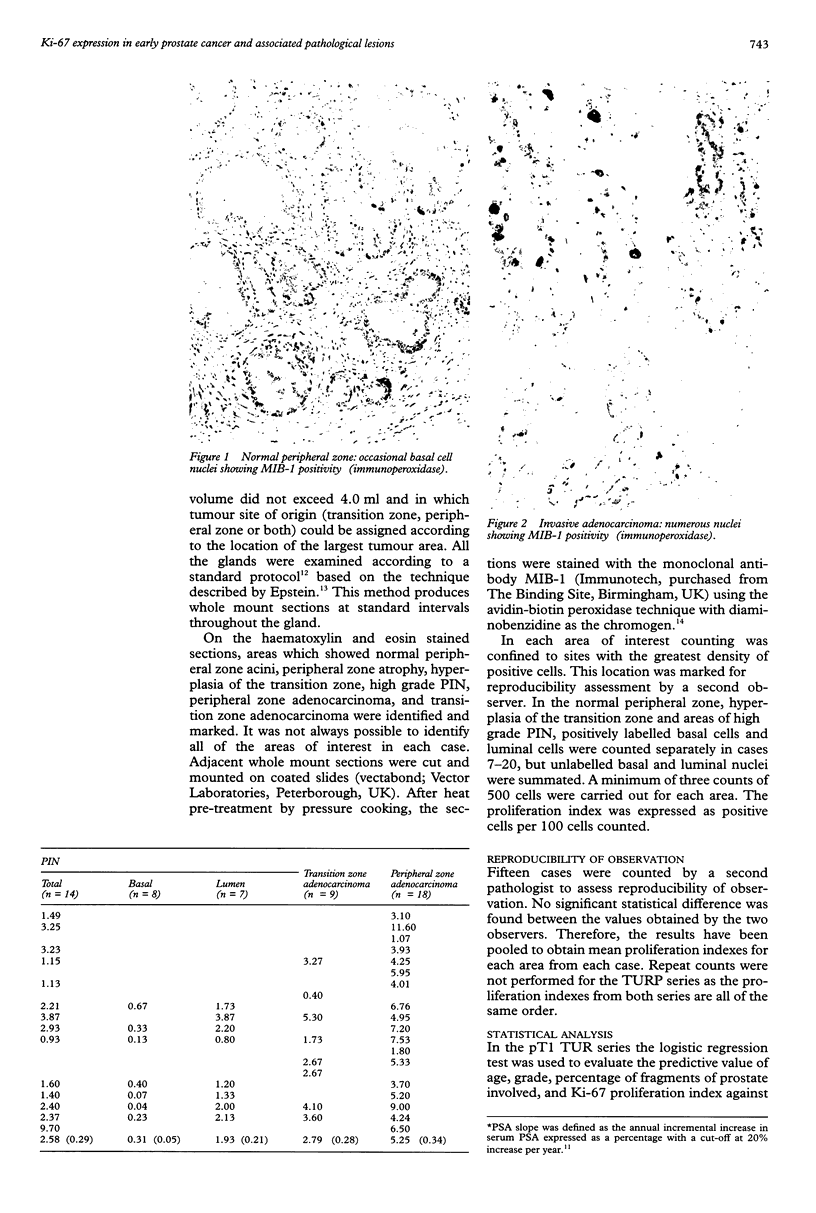
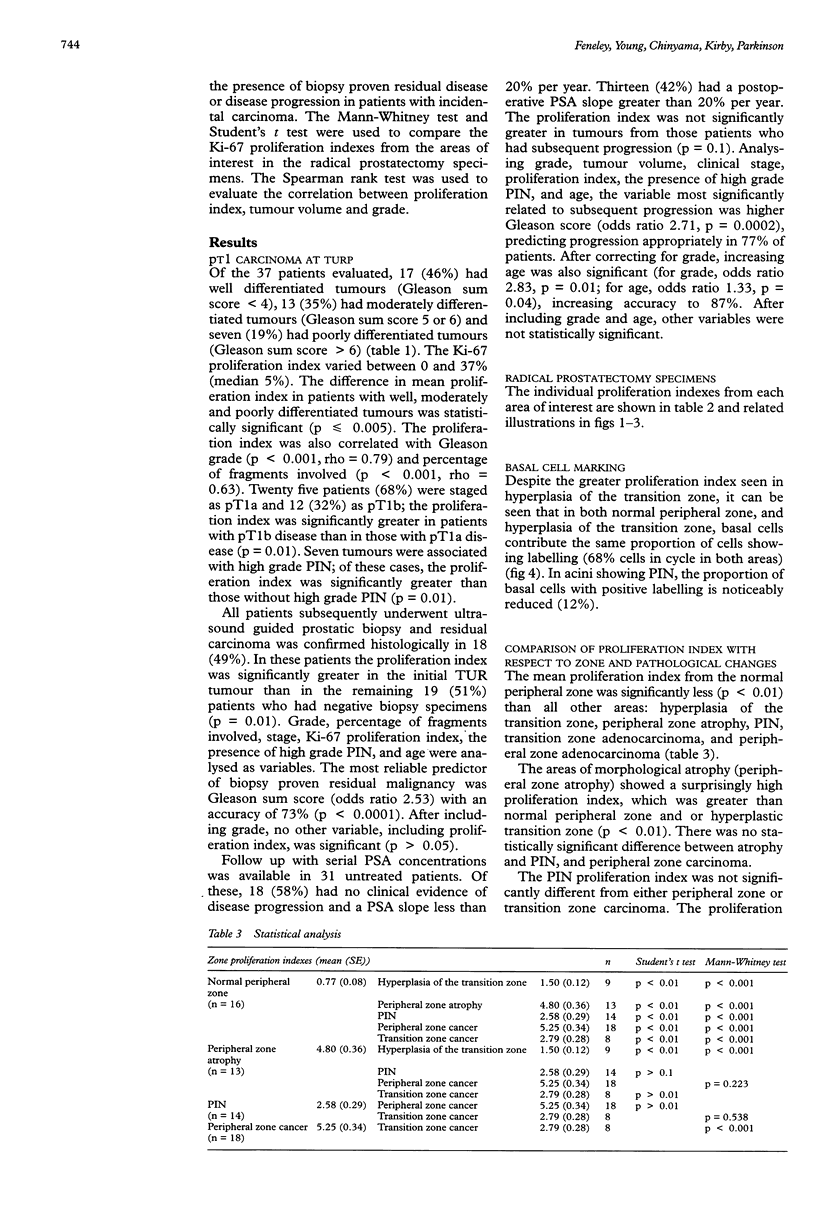
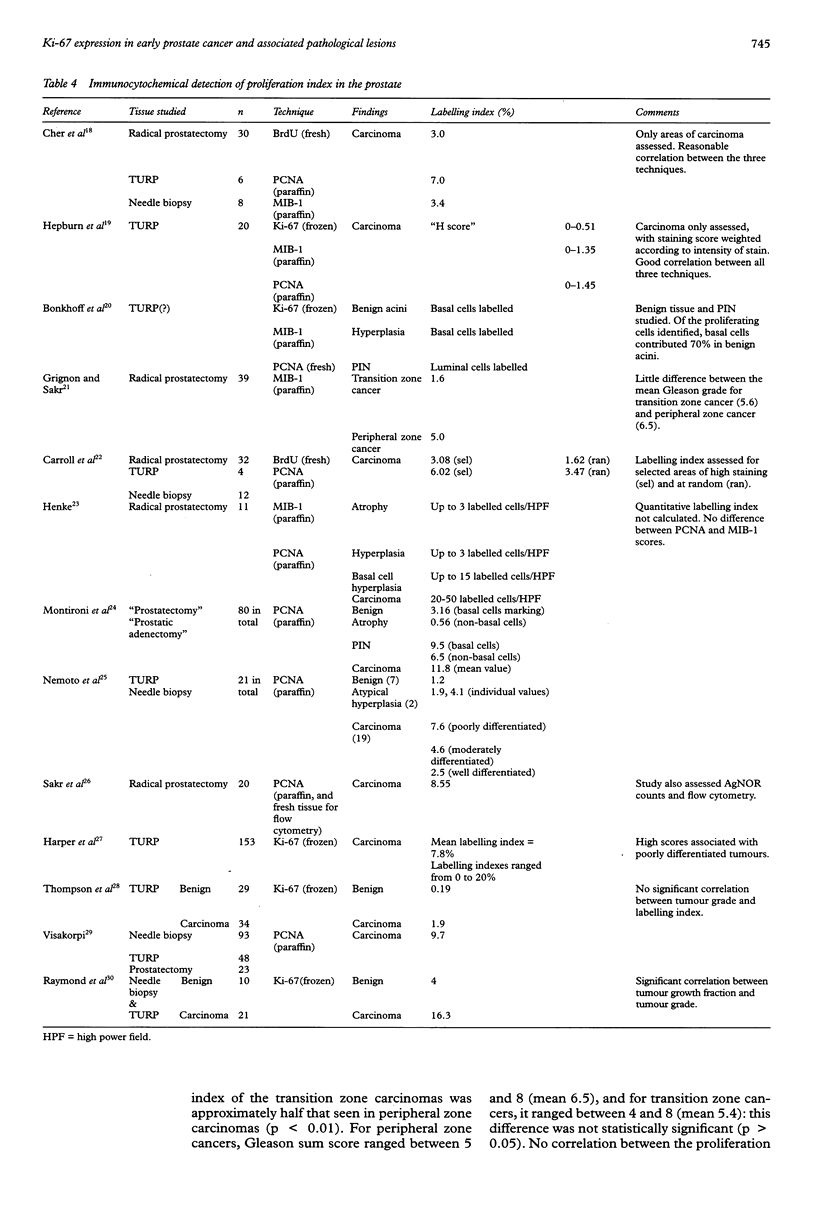
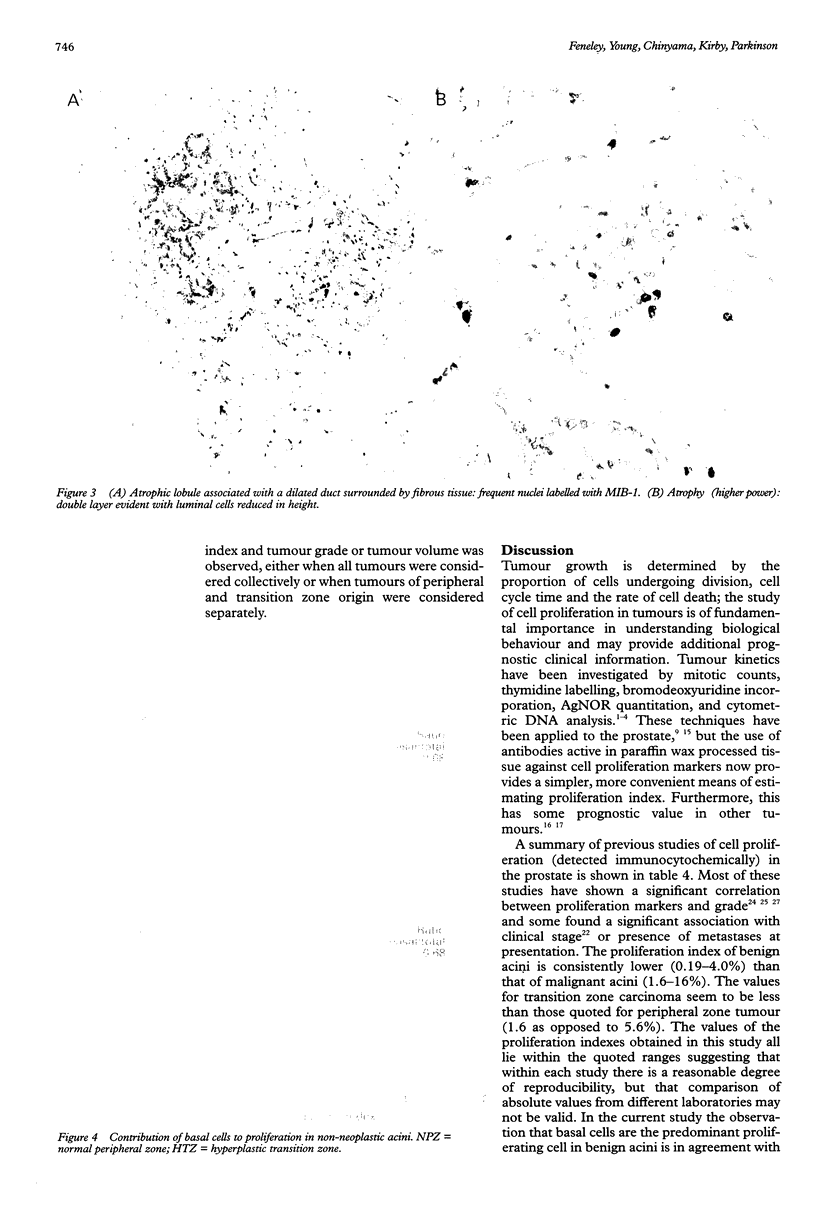
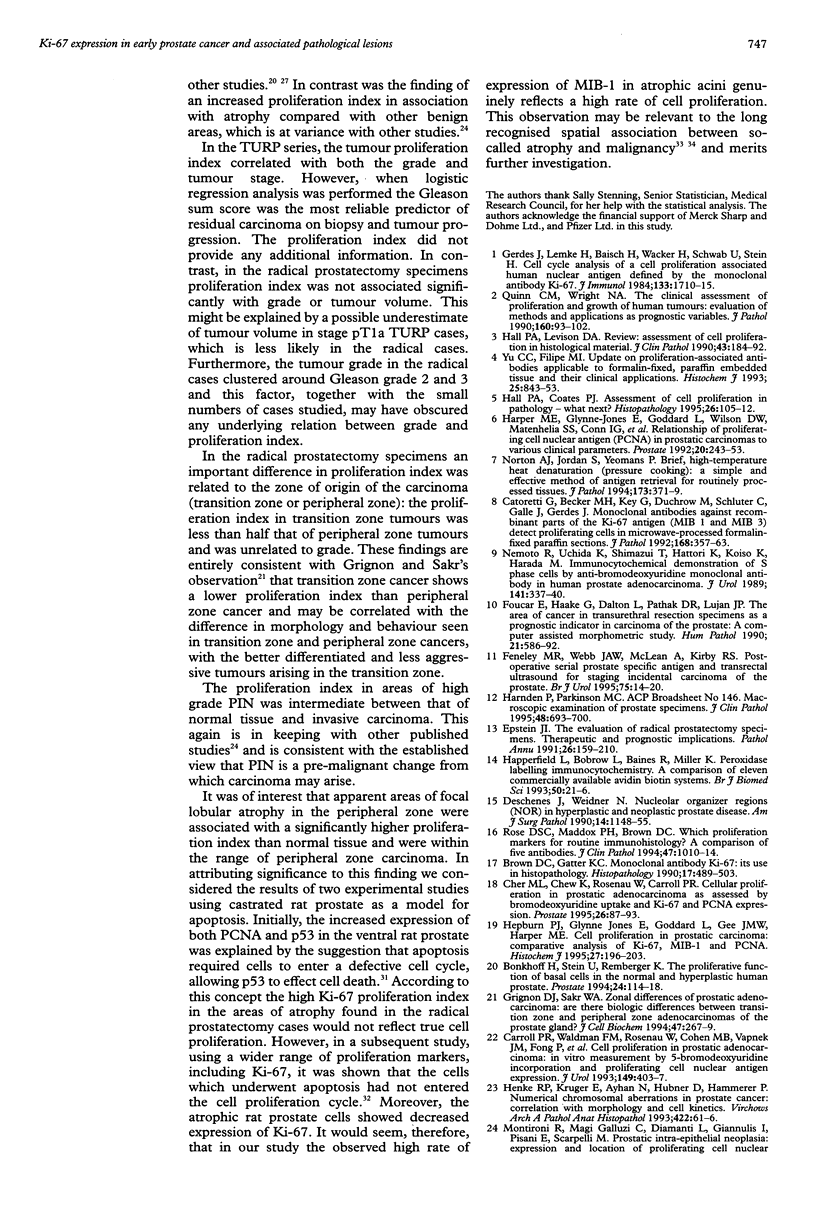
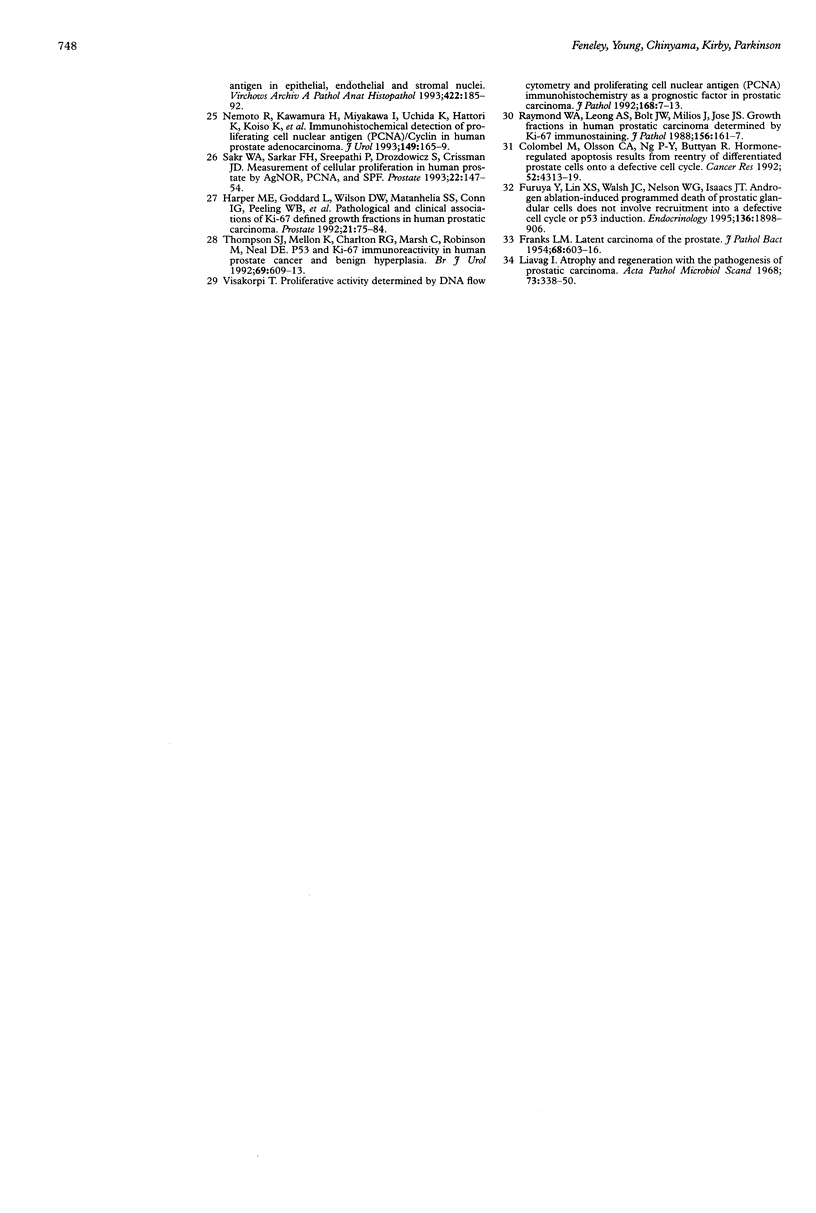
Images in this article
Selected References
These references are in PubMed. This may not be the complete list of references from this article.
- Bonkhoff H., Stein U., Remberger K. The proliferative function of basal cells in the normal and hyperplastic human prostate. Prostate. 1994;24(3):114–118. doi: 10.1002/pros.2990240303. [DOI] [PubMed] [Google Scholar]
- Brown D. C., Gatter K. C. Monoclonal antibody Ki-67: its use in histopathology. Histopathology. 1990 Dec;17(6):489–503. doi: 10.1111/j.1365-2559.1990.tb00788.x. [DOI] [PubMed] [Google Scholar]
- Carroll P. R., Waldman F. M., Rosenau W., Cohen M. B., Vapnek J. M., Fong P., Narayan P., Mayall B. H. Cell proliferation in prostatic adenocarcinoma: in vitro measurement by 5-bromodeoxyuridine incorporation and proliferating cell nuclear antigen expression. J Urol. 1993 Feb;149(2):403–407. doi: 10.1016/s0022-5347(17)36104-9. [DOI] [PubMed] [Google Scholar]
- Cattoretti G., Becker M. H., Key G., Duchrow M., Schlüter C., Galle J., Gerdes J. Monoclonal antibodies against recombinant parts of the Ki-67 antigen (MIB 1 and MIB 3) detect proliferating cells in microwave-processed formalin-fixed paraffin sections. J Pathol. 1992 Dec;168(4):357–363. doi: 10.1002/path.1711680404. [DOI] [PubMed] [Google Scholar]
- Cher M. L., Chew K., Rosenau W., Carroll P. R. Cellular proliferation in prostatic adenocarcinoma as assessed by bromodeoxyuridine uptake and Ki-67 and PCNA expression. Prostate. 1995 Feb;26(2):87–93. doi: 10.1002/pros.2990260205. [DOI] [PubMed] [Google Scholar]
- Colombel M., Olsson C. A., Ng P. Y., Buttyan R. Hormone-regulated apoptosis results from reentry of differentiated prostate cells onto a defective cell cycle. Cancer Res. 1992 Aug 15;52(16):4313–4319. [PubMed] [Google Scholar]
- Deschênes J., Weidner N. Nucleolar organizer regions (NOR) in hyperplastic and neoplastic prostate disease. Am J Surg Pathol. 1990 Dec;14(12):1148–1155. doi: 10.1097/00000478-199012000-00007. [DOI] [PubMed] [Google Scholar]
- Epstein J. I. The evaluation of radical prostatectomy specimens. Therapeutic and prognostic implications. Pathol Annu. 1991;26(Pt 1):159–210. [PubMed] [Google Scholar]
- FRANKS L. M. Latent carcinoma of the prostate. J Pathol Bacteriol. 1954 Oct;68(2):603–616. doi: 10.1002/path.1700680233. [DOI] [PubMed] [Google Scholar]
- Feneley M. R., Webb J. A., McLean A., Kirby R. S. Post-operative serial prostate-specific antigen and transrectal ultrasound for staging incidental carcinoma of the prostate. Br J Urol. 1995 Jan;75(1):14–20. doi: 10.1111/j.1464-410x.1995.tb07225.x. [DOI] [PubMed] [Google Scholar]
- Foucar E., Haake G., Dalton L., Pathak D. R., Lujan J. P. The area of cancer in transurethral resection specimens as a prognostic indicator in carcinoma of the prostate: a computer-assisted morphometric study. Hum Pathol. 1990 Jun;21(6):586–592. doi: 10.1016/s0046-8177(96)90003-9. [DOI] [PubMed] [Google Scholar]
- Furuya Y., Lin X. S., Walsh J. C., Nelson W. G., Isaacs J. T. Androgen ablation-induced programmed death of prostatic glandular cells does not involve recruitment into a defective cell cycle or p53 induction. Endocrinology. 1995 May;136(5):1898–1906. doi: 10.1210/endo.136.5.7720636. [DOI] [PubMed] [Google Scholar]
- Gerdes J., Lemke H., Baisch H., Wacker H. H., Schwab U., Stein H. Cell cycle analysis of a cell proliferation-associated human nuclear antigen defined by the monoclonal antibody Ki-67. J Immunol. 1984 Oct;133(4):1710–1715. [PubMed] [Google Scholar]
- Grignon D. J., Sakr W. A. Zonal origin of prostatic adenocarcinoma: are there biologic differences between transition zone and peripheral zone adenocarcinomas of the prostate gland? J Cell Biochem Suppl. 1994;19:267–269. [PubMed] [Google Scholar]
- Hall P. A., Coates P. J. Assessment of cell proliferation in pathology--what next? Histopathology. 1995 Feb;26(2):105–112. doi: 10.1111/j.1365-2559.1995.tb00639.x. [DOI] [PubMed] [Google Scholar]
- Hall P. A., Levison D. A. Review: assessment of cell proliferation in histological material. J Clin Pathol. 1990 Mar;43(3):184–192. doi: 10.1136/jcp.43.3.184. [DOI] [PMC free article] [PubMed] [Google Scholar]
- Happerfield L. C., Bobrow L. G., Bains R., Miller K. D. Peroxidase labelling immunocytochemistry: a comparison of eleven commercially-available avidin-biotin systems. Br J Biomed Sci. 1993 Mar;50(1):21–26. [PubMed] [Google Scholar]
- Harnden P., Parkinson M. C. ACP Broadsheet No 146: August 1995. Macroscopic examination of prostatic specimens. J Clin Pathol. 1995 Aug;48(8):693–700. doi: 10.1136/jcp.48.8.693. [DOI] [PMC free article] [PubMed] [Google Scholar]
- Harper M. E., Glynne-Jones E., Goddard L., Wilson D. W., Matenhelia S. S., Conn I. G., Peeling W. B., Griffiths K. Relationship of proliferating cell nuclear antigen (PCNA) in prostatic carcinomas to various clinical parameters. Prostate. 1992;20(3):243–253. doi: 10.1002/pros.2990200309. [DOI] [PubMed] [Google Scholar]
- Harper M. E., Goddard L., Wilson D. W., Matanhelia S. S., Conn I. G., Peeling W. B., Griffiths K. Pathological and clinical associations of Ki-67 defined growth fractions in human prostatic carcinoma. Prostate. 1992;21(1):75–84. doi: 10.1002/pros.2990210108. [DOI] [PubMed] [Google Scholar]
- Henke R. P., Krüger E., Ayhan N., Hübner D., Hammerer P. Numerical chromosomal aberrations in prostate cancer: correlation with morphology and cell kinetics. Virchows Arch A Pathol Anat Histopathol. 1993;422(1):61–66. doi: 10.1007/BF01605134. [DOI] [PubMed] [Google Scholar]
- Hepburn P. J., Glynne-Jones E., Goddard L., Gee J. M., Harper M. E. Cell proliferation in prostatic carcinoma: comparative analysis of Ki-67, MIB-1 and PCNA. Histochem J. 1995 Mar;27(3):196–203. [PubMed] [Google Scholar]
- Liavåg I. Atrophy and regeneration in the pathogenesis of prostatic carcinoma. Acta Pathol Microbiol Scand. 1968;73(3):338–350. doi: 10.1111/j.1699-0463.1968.tb04602.x. [DOI] [PubMed] [Google Scholar]
- Montironi R., Galluzzi C. M., Diamanti L., Giannulis I., Pisani E., Scarpelli M. Prostatic intra-epithelial neoplasia: expression and location of proliferating cell nuclear antigen in epithelial, endothelial and stromal nuclei. Virchows Arch A Pathol Anat Histopathol. 1993;422(3):185–192. doi: 10.1007/BF01621801. [DOI] [PubMed] [Google Scholar]
- Nemoto R., Kawamura H., Miyakawa I., Uchida K., Hattori K., Koiso K., Harada M. Immunohistochemical detection of proliferating cell nuclear antigen (PCNA)/cyclin in human prostate adenocarcinoma. J Urol. 1993 Jan;149(1):165–169. doi: 10.1016/s0022-5347(17)36031-7. [DOI] [PubMed] [Google Scholar]
- Nemoto R., Uchida K., Shimazui T., Hattori K., Koiso K., Harada M. Immunocytochemical demonstration of S phase cells by anti-bromodeoxyuridine monoclonal antibody in human prostate adenocarcinoma. J Urol. 1989 Feb;141(2):337–340. doi: 10.1016/s0022-5347(17)40760-9. [DOI] [PubMed] [Google Scholar]
- Norton A. J., Jordan S., Yeomans P. Brief, high-temperature heat denaturation (pressure cooking): a simple and effective method of antigen retrieval for routinely processed tissues. J Pathol. 1994 Aug;173(4):371–379. doi: 10.1002/path.1711730413. [DOI] [PubMed] [Google Scholar]
- Quinn C. M., Wright N. A. The clinical assessment of proliferation and growth in human tumours: evaluation of methods and applications as prognostic variables. J Pathol. 1990 Feb;160(2):93–102. doi: 10.1002/path.1711600202. [DOI] [PubMed] [Google Scholar]
- Raymond W. A., Leong A. S., Bolt J. W., Milios J., Jose J. S. Growth fractions in human prostatic carcinoma determined by Ki-67 immunostaining. J Pathol. 1988 Oct;156(2):161–167. doi: 10.1002/path.1711560211. [DOI] [PubMed] [Google Scholar]
- Rose D. S., Maddox P. H., Brown D. C. Which proliferation markers for routine immunohistology? A comparison of five antibodies. J Clin Pathol. 1994 Nov;47(11):1010–1014. doi: 10.1136/jcp.47.11.1010. [DOI] [PMC free article] [PubMed] [Google Scholar]
- Sakr W. A., Sarkar F. H., Sreepathi P., Drozdowicz S., Crissman J. D. Measurement of cellular proliferation in human prostate by AgNOR, PCNA, and SPF. Prostate. 1993;22(2):147–154. doi: 10.1002/pros.2990220207. [DOI] [PubMed] [Google Scholar]
- Thompson S. J., Mellon K., Charlton R. G., Marsh C., Robinson M., Neal D. E. P53 and Ki-67 immunoreactivity in human prostate cancer and benign hyperplasia. Br J Urol. 1992 Jun;69(6):609–613. doi: 10.1111/j.1464-410x.1992.tb15632.x. [DOI] [PubMed] [Google Scholar]
- Visakorpi T. Proliferative activity determined by DNA flow cytometry and proliferating cell nuclear antigen (PCNA) immunohistochemistry as a prognostic factor in prostatic carcinoma. J Pathol. 1992 Sep;168(1):7–13. doi: 10.1002/path.1711680103. [DOI] [PubMed] [Google Scholar]
- Yu C. C., Filipe M. I. Update on proliferation-associated antibodies applicable to formalin-fixed paraffin-embedded tissue and their clinical applications. Histochem J. 1993 Dec;25(12):843–853. [PubMed] [Google Scholar]



